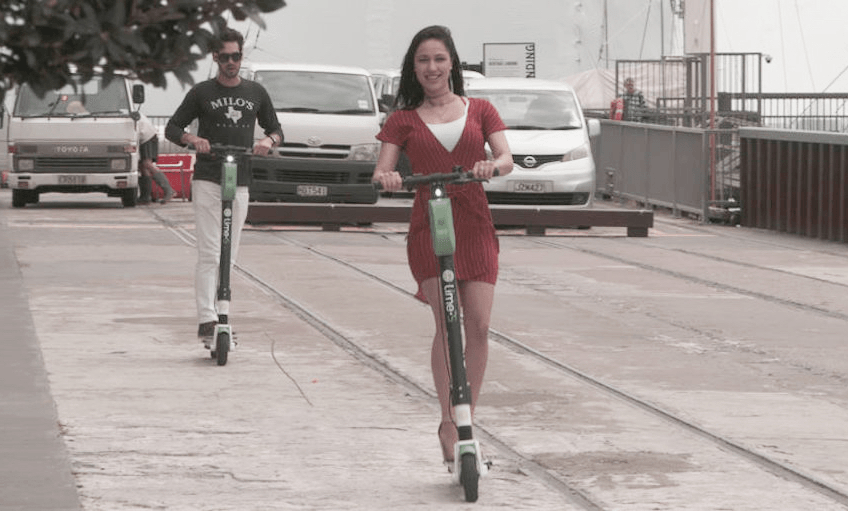The answer to the Lime scooter/pedestrian conflict is right in front of us, says Jessica Rose of the group Women in Urbanism.
A confession: I didn’t think Lime scooters would take off when they appeared on our streets overnight. Now I believe Limes could be the transport tool the people of this city both need and deserve. I’m still surprised that someone plonked a couple of hundred fairly uncool electric scooters on the side of the road and people just took to them. But now that money is burning a hole in all kinds of people’s pockets in order to buy one of their own for getting around, it’s time to think about where we’re going to put them so people can use them safely.
I’ve spent about six years advocating for the creation of protected bike lanes in Auckland. Why? Because if you have a transport question, a bicycle is the answer. I’ve campaigned to normalise the riding of bikes for general trips, anywhere, wearing normal clothes, with a primary focus on encouraging women to feel safe. After all that work trying to get people to ride bicycles more often – and don’t get me wrong, they really are doing it – this Lime scooter thing happens.
And it’s awesome. It’s a reminder that there isn’t anything wrong with broadening our horizons when it comes to how we use the road corridor – that’s the road, berm and footpath. It is a shared space, owned by all of us, and it is for the purpose of moving people and things from here to there.
Currently this space is unfairly dedicated to one dominant form of transport: the private motor car, which for a time between 1950 and 1990 made a lot of sense. But it doesn’t make as much sense now, with so many more people living in urban cities, close to work, school, play and stuff to do. And as much as it’s a new concept for many in the bike community to chew on, the bicycle – just like the car – isn’t the only solution to getting around the city.
But if we thought bikelash was bad, Limelash is worse, however misinformed it is.
That isn’t to say there aren’t real concerns about where an e-scooter should go. It’s not the road and it’s not the footpath, so where?
A recent article titled “How should e-scooters be regulated?” provides a few legal solutions, but how could this look on the ground? This is where my new buzz is at, and I’m calling it ‘The Little Road’, or ‘Rori Iti’ in te reo. The Little Road sits between the Road and the Footpath. Let me break it down:
The Road is for cars, buses, delivery vehicles, motor scooters, motorbikes, Ubers, taxis, and light rail, for example. It has a total speed limit of 30km/h, or 50, or 80, depending on where it is and what it’s primarily used for.
The Little Road / Rori Iti would be for mobility scooters, electric and push scooters, e-skateboards, bikes and e-bikes, segways… you get the picture. The Little Road would have a speed limit of under 30km/h.
Then you have the footpath for people walking (speed limit 6km/h). This space is for our most vulnerable users, the people we need to protect the most: the elderly, young or access needs people who have the most difficulty moving freely in an urban space that is pretty stacked against them doing so. This last category includes a disproportionate number of women since women are more likely to be primary caregivers, and are more likely to walk or take public transport.
It was only when I’d thought all this through that I was alerted to Jarrett Walker’s article, “Do we need a new name and theory for ‘bike lanes”’. Turns out he’d already wrote all this down, better, and I found I’d potentially answered the question, and forgotten about where we were putting dogs.
It seems we in Aotearoa are overdue a review of the classification framework that includes all the new road users and vehicles. We need something that can promote a complete and inclusive transport corridor – one which responds to differing gender and age needs. Because whether it be Lime, walk, bus or bike, as long as the priority goes to shared, safe, and low carbon transport options, everyone will benefit.
If we truly care about planning our towns and cities in a more equitable way we will give space to the incredibly diverse Limers. From teenagers (over 18 only, of course!) on the way to university, to yo-pros heading to work; from couples on date night to elderly ladies trying to get from Mayoral Drive up to Karangahape Road; and from middle-aged-men in suits off to meetings to young girls who don’t feel safe walking on the footpaths at night. They’re all welcome on our streets. We just need to rethink how to share the space, in a way that’s better for everyone.
The Bulletin is The Spinoff’s acclaimed, free daily curated digest of all the most important stories from around New Zealand delivered directly to your inbox each morning.
